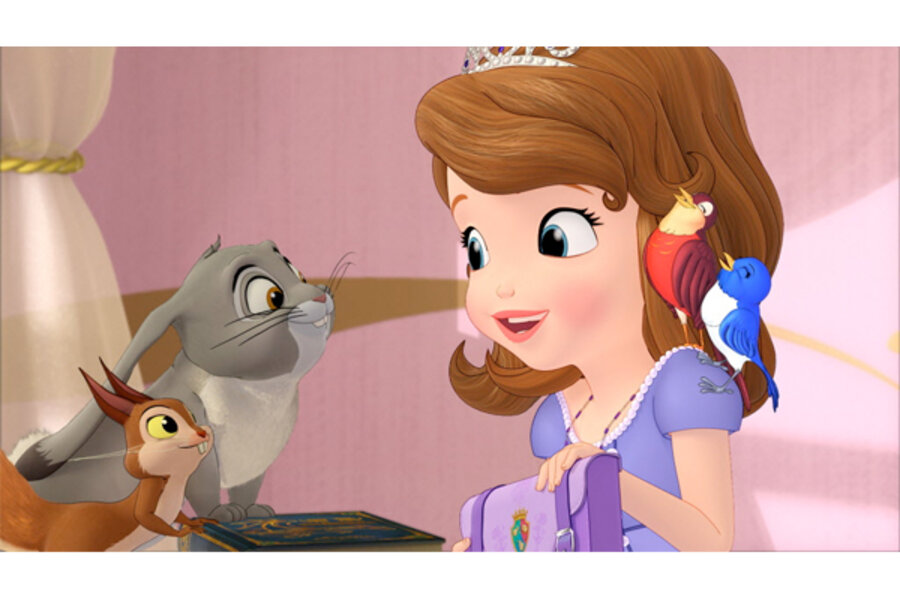Princess Sofia and Skinny Minnie: Disney characters suffer backlash
Updated 4:08 p.m. EST
The appearance of Disney characters is under fire again, with controversy erupting over a holiday Barneys campaign that will feature skinnier versions of beloved Disney cartoons as well as the facial features of the company’s newest princess, Princess Sofia.
Barneys, the high-end New York department store, announced in August that Disney characters would be the stars of their holiday window displays, but in different incarnations than we’re used to seeing them. Goofy, Daisy Duck, Minnie Mouse and others will be featured in the store’s windows, but as emaciated versions of themselves, with Mickey’s girlfriend Minnie in particular stretched so she’s tall and willowy.
“No time like the holidays to convince a little girl that beloved Minnie, in her regular shape, is fat,” the Monitor's Modern Parenthood blogger Stephanie Hanes wrote at the time. This isn’t the first time traditional Disney characters have experienced controversial makeovers, either – a Venezuelan ad for plastic surgery used Ariel as a model. A model, depicting her swimming over to a table for an operation, then leaving with plumped-up lips and a larger chest.
Are you a 'Helicopter Parent?' Take our quiz!
A petition on Change.org against the Barneys campaign, titled "Barneys: Leave Minnie Mouse Alone," has gotten more than 133,000 signatures, including those of Abigail Disney, “Sideways” star Virginia Madsen, and “True Blood” actress Kristin Bauer van Straten.
“Girls have enough pressure to be thin, now the beloved Disney mouse of their childhood has to add to the message that the only good body is a tall, size 0 body?” Ragen Chastain, who created the petition, wrote. “Enough already.”
Disney and Barneys told the New York Daily News that "[critics] have deliberately ignored previously released information clearly stating this promotion is a three-minute ‘moving art’ video featuring traditional Minnie Mouse in a dreamlike sequence set in Paris where she briefly walks the runway as a model and then happily awakens as her normal self wearing the very same designer dress from the fashion show."
Meanwhile, the Disney Channel is introducing its newest princess, Princess Sofia, in a TV movie, "Sofia the First: Once Upon a Princess," but some fans have protested Sofia’s looks. The new character was trumpeted at first as the first Latina Disney princess, with the movie’s executive producer Jamie Mitchell stating earlier this month that she would be the first Disney Latina character, period.
Sofia has light brown hair and blue eyes, and skin that is not dark. Some fans applauded the decision to have a Latina character have lighter skin, while others said the character should have darker skin to represent more of the Latina population.
“Disney’s ‘first Latina princess’ looks… not Latina,” one Twitter user, Amy Rubinson, tweeted.
Now Disney may be distancing themselves a bit from their earlier comments.
“What's important to know is that Sofia is a fairy-tale girl who lives in a fairy-tale world," senior vice president of original programming and general manager of Disney Junior Worldwide Nancy Kanter said in an interview with NBC Latino. "All our characters come from fantasy lands that may reflect elements of various cultures and ethnicities but none are meant to specifically represent those real world cultures.”
Craig Gerber, co-executive producer of "Sofia the First," said on Facebook that Sofia’s mother comes from a country inspired by Spain and her father from a kingdom that is similar to Scandinavia. In the movie “Sofia,” the main character becomes a princess when her mother marries the king of a country called Enchancia.
Are you a 'Helicopter Parent?' Take our quiz!
“They seem to be backpedaling," said Lisa Navarrete, spokeswoman for the National Council of La Raza, in an interview with the Associated Press. "They've done such a good job in the past when they've introduced Native American, African-American and Asian princesses. They made a big deal out of it, and there was a lot of fanfare, but now they're sort of scrambling. It's unusual because Disney has been very good about Latino diversity."
[Editor's note: After this column was posted, executive director of media relations for Disney Channels Dana Green contacted us to let us know that the National Hispanic Media Coalition had met with Ms. Kanter to discuss the issue and that Kanter had stated Sofia is not Latina and that Mitchell had misspoken. The National Hispanic Media Coalition said in a statement that it "celebrate[d] the good news" that Disney Junior is planning a project in which a Latina will be the main character on a show and that the NHMC agreed to give Disney a writers alumni list from the coalition's writers program "in an effort to help create authentic, three-dimensional Latino characters."]






